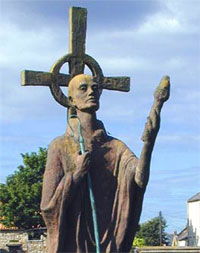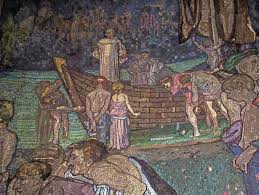
Summary: St Aidan , had a reputation of being a gentle but effective missionary in the English kingdom of Northumbria. He founded the monastery of Lindisfarne.
Patrick Duffy tells his story.
A Monk of Iona
 Aidan was a monk of Irish descent on the island of Iona. During the struggles for the kingship of Northumbria, two sons of the king found refuge in Iona. When the younger of these Oswald eventually became king in 634, he invited the monks of Iona to send a mission to evangelise Northumbria. Aidan was of Irish descent and made his headquarters at Lindisfarne. With the aid of the king as interpreter he was very successful in his mission.
Aidan was a monk of Irish descent on the island of Iona. During the struggles for the kingship of Northumbria, two sons of the king found refuge in Iona. When the younger of these Oswald eventually became king in 634, he invited the monks of Iona to send a mission to evangelise Northumbria. Aidan was of Irish descent and made his headquarters at Lindisfarne. With the aid of the king as interpreter he was very successful in his mission.
A Simple Message
The first monk from Iona who came, Colmán, was combative in temperament. He dismissed the local people as “obstinate and barbarous” and in less than a year went back to Iona. Aidan, who was sent on a second mission the following year, felt Colmán had been too harsh, and decided on simpler approach. He became firm friends with King Oswald, whom he had known in Iona. Aidan also used Oswald, who had become bilingual during his time on Iona, as his interpreter and soon became bilingual himself, bringing the gospel everywhere he went, to rich and poor alike. He had the great missionary virtues of patience and openness to everyone he met.
Aidan Begins

Modern image of St Aidan
Aidan founded a monastery and school for twelve young boys on the island of Lindisfarne. It was within sight of the King’s castle at Bamburgh. Two of his disciples, Cedd and Chad, later became missionaries and brought Celtic Christianity into Mercia, the Midlands area of present-day England. When Oswald died in 642, Aidan received continued support from King Oswin of Deira and the two became close friends.
Encouraged St Hilda of Whitby
Aidan also encouraged women in the religious life and was friend and spiritual director to the abbess Hilda at Whitby. This was a monastery in the Celtic style, with men and women living separately in small houses, but worshipping together in church.
Death and Burial

St Aidan saving slaves
Strongly opposed to slavery, Aidan spent much time and effort in ransoming slaves and sending them home. When he died at Bamburgh Castle in 651, his body was taken back to Iona for burial.
Bede in his Ecclesiastical History of the English People portrays him with the virtues that were also his own: ‘a teacher with a passionate love of goodness, tempered with humility, warmth and gentleness’.